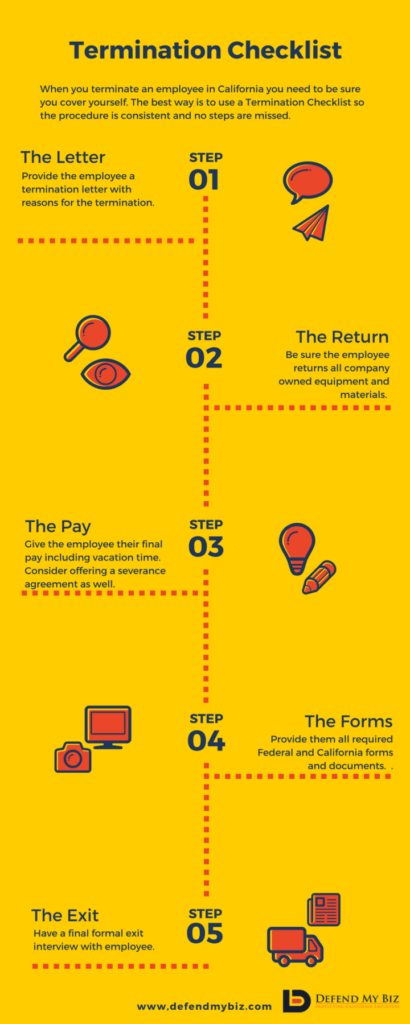
Posted on September 17th, 2017
Sooner or later every employer has to let go of an employee.
Look it not always easy for us but its part of owning a business. But in California we have to worry about more than just the emotional piece of parting with employees.
We have to be concerned about a former employee using the states unfair labor laws against us. As we discussed in this article, employee typically sue when they have some personal animosity towards you or your business.
Its why you need a California termination checklist.
How you handle the process of termination can impact an employee’s decision to file a claim against you.
A disgruntled employee can cause you real problems and being on the wrong end of certain types of claims like a class action lawsuit could literally put you out of business.
We put together this InfoGraph for you (below is the full article with details)
Anytime you fire an employee make sure to follow a termination checklist so you reduce your chances of being hit with a wrongful termination claim.
Quick Guide: Termination Checklist Infographic
Want to share this image on your site? Just copy and paste the embed code below:
Why you need a Wrongful Termination Checklist
A wrongful termination happens when there are one or more terms affected in the contract of employment during the process of termination. We always encourage our employers to have a solid employee policies and procedures in place before terminating an employee.
This check list contains key points that you need to know before terminating an employee, including which violations justifies a termination, it also helps you remember to honor any agreements made in a contract of employment.
The main purpose of the list is to help you stay clear of common mistakes employers make while letting go of an employee.
What Justifies A Termination?
Again since the state is at-will you can fire for reasons you find justifiable. But its best to define those in your own company policies.
Below are some example reasons companies typically give to terminating an employee.
Unsatisfactory Attendance
You need to provide your employee with written requirements for showing up to work. These guidelines must comply with all state and federal laws involving family medical Leave, military service, disability, jury duty, school children activities and other issues.
Make sure to inform your employee in written form of his/her work schedule.
Unsatisfactory Job Performance
The expectation of employee performance should be the same for all employees with the same job title. Make sure to keep copies of any memos or any documents in which you informed your employee about unsatisfactory performance. If during the process you took disciplinary measures regarding the unsatisfactory performance, keep all your copies in your records.
Unsatisfactory Conduct
- Determine why the unsatisfactory conduct occurred and inform the employee in writing form.
- Apply the same standard for discipline for ALL employees and keep records.
- Always have available to your employees an employee handbook, memo or policy and procedure standards of conduct.
- Use prior employee misconduct in the decision to terminate.
- Give the employee a fair hearing of his/her side of the situation.
Letter Offer or Contract
Most employees are considered at will and California is an at will employment state. This means generally speaking you can fire an employee for anything but the protected reasons.
But you must review all the conditions associated with the employee you want to terminate, including any agreements or contracts since you need to honor those terms before terminating.
Have your copy of your written and signed letter offer or contract in your files in case you need it.
Employment Ending Checklist
Practical Requirements; here are steps you should take that are not necessarily legally required but we recommend.
- Provide your terminated employee with a letter of termination where you give the reason for the termination. (this can potentially discourage later accusations that the firing was for an improper reason)
- Make sure the employee returns all property that belongs to your company and was provided to perform the job. For example, laptop personal computers, company cars, company documents, etc.
- Always have an ‘exit interview’ with the employee. If you feel like your relationship with them is to contentious have someone from your company (preferably HR if you have them) do the interview.
- Always try to get a severance agreement with your departing employee. Even if you do not believe they have a reason to sue you this is a nice insurance policy. You are basically giving them something (2 weeks extra pay etc) for them to agree not bring any claims against you. Make sure this is in writing and they sign it.
Federal Termination Requirements;
here are forms/notices Federal law requires you provide your terminated employee (as of the time of this writing)
- COBRA Notice and election form for employees participating in your company group health plan. (only required if you have 20 employees or more).
- If the reason for termination is covered by any of the conditions in the WARN ACT you must provide notice 60 days before termination (only required if you have 100 employees or more).
- A Retirement Plan Participant Notice is required for terminated employees who were part of your retirement benefits plan. It describes their benefits and the procedure on how to obtain them now that they are no longer with you.
State of California Termination Requirements
here are forms/notices California law requires you provide your terminated employee (as of the time of this writing)
- The California EDD requires you to provide an Unemployment benefits pamphlet to all laid off or discharged workers before the date of the termination.
- The Department of Health Care Services requires you the employer to provide the Health Insurance Premium Payment to certain employees covered under the program, (only required if you have 20 employees or more).
- California Unemployment Insurance Code 1089 requires you to give a written Notice to Employee as to Change in Relationship form immediately upon termination. No written notice is required if the employee voluntarily quit.
- California Labor Code Section 2808(b) requires you to provide the terminated employee, notification of all employer-sponsored coverage for which the employee may remain eligible after they are terminated.
- You must notify any covered, terminated employees of their Cal-COBRA continuation rights. Cal-COBRA must be offered to terminated employees for small business (2-19 employees) and terminated employees covered under federal COBRA when their 18 months of federal COBRA coverage expire.
- The Worker Adjustment and Retraining Notification Act requires you to give affected employees at least 60 days written advance notice of any major closings or mass layoffs.
The Termination Meeting
During this meeting you or your human resources representative will inform the employee of his termination. Make sure you have all documentation ready that explains the reasons why the employee is getting fired. You should also have another manager with you during this meeting or a supervisor that can offer support in case it’s needed.
Many times even when the employee recognizes he/she is at fault, a termination can be a harsh sudden event. It is better to be thoughtful and sympathetic during a termination and always follow the law.
You will want to avoid any temptation to be harsh even with a real problem employee during termination. This is because the more bad blood or anger the ex employee has towards you the more likely they are to file a lawsuit.
Remember the goal of terminating a problem employee is to successfully sever the relationship. The last thing you want is them popping back up in your life again in a few months, this time armed with a lawyer.

Book a FREE 15 Minute Consultation with me today so I can listen to your story and tell you exactly what you need to do to get rid of your employee problems.
Download My Free Ebook: ‘6 Tips To Protect Your California Business From an Employee Lawsuit’

